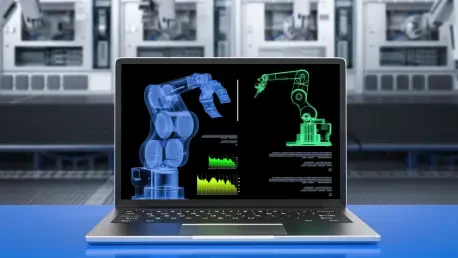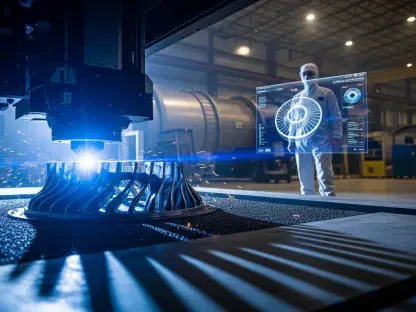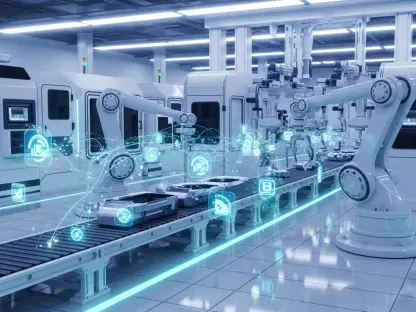As the digital age advances, breakthroughs in artificial intelligence continue to reshape industries, and NVIDIA stands at the forefront of this transformation. By expanding the Omniverse Blueprint for AI factory digital twins, NVIDIA embarks on a mission to revolutionize the building and management of AI factories, introducing a sophisticated suite of tools aimed at optimizing design aspects such as power efficiency, cooling systems, and network capabilities. This strategic expansion leverages the power of digital twin technology, a virtual model of physical systems, to simulate AI factory components before actual construction begins. Doing so enhances the ability to preemptively address potential design issues, streamlining the path to creating more intelligent and reliable AI factories.
Enhancements in the Omniverse Blueprint
Tool Expansion and New Partnerships
The expansion of NVIDIA’s Omniverse Blueprint is notably marked by the inclusion of tools from leading industry partners such as Delta Electronics, Jacobs, Siemens, Cadence, and Schneider Electric with ETAP, along with power giant Vertiv. These collaborations are instrumental in refining simulation processes that serve as the virtual testing grounds for AI factories. By integrating these advanced tools, NVIDIA aims to create dynamic simulations that allow engineering teams to fine-tune AI infrastructure components, leading to increased effectiveness in energy efficiency and systemic throughput. This symbiotic incorporation demonstrates NVIDIA’s commitment to a holistic approach in digital twin applications that maximizes resource optimization and innovation.
Incorporating these partnerships into the Omniverse Blueprint, NVIDIA not only enhances the scope of functional simulations but also ensures the accuracy of these digital representations. This comprehensive integration showcases a collaborative effort to develop state-of-the-art AI factory infrastructure meeting modern demands. The strategic choice of partners like Cadence and Siemens is significant, as they bring cutting-edge modeling capabilities to the table, contributing to the precision and operational efficiency of these digital twins. Siemens, in particular, adds 3D modeling capacities to the platform, boosting the virtual representation and performance prediction accuracy of the AI factories.
Simulation Precision and Open Standards
One of the most pertinent advancements brought by the updated blueprint is the use of open standards like Universal Scene Description (OpenUSD). Employing OpenUSD, the Omniverse Blueprint ensures a comprehensive synthesis of 3D and simulation data, providing engineering teams with robust tools to visualize and optimize potential design elements in data centers. This approach ensures the capacity to foresee and rectify costly design inefficiencies, allowing AI factories to achieve enhanced resilience and output. Such precision in simulation underscores the industry’s shift towards integrating open standards that foster seamless collaboration and innovation.
The drive to achieve high-fidelity simulations is bolstered by the addition of SimReady standardization. This standardization process simplifies the adaptation and evaluation of simulations, facilitating in-depth analysis of vital components like thermal airflow in digital environments. The inclusion of SimReady signals a major stride forward in ensuring that digital twins not only mimic real-world conditions but also provide a reliable base for potential design enhancements. By achieving detailed simulation accuracy, engineering teams in various industries can align these advanced models with real-world scenarios effectively, thus streamlining the creation of optimized and resilient AI systems.
Digital Twin Technology and Its Impacts
Energy Efficiency and Operational Optimization
The significance of digital twins in improving energy efficiency remains paramount, as these virtual counterparts allow comprehensive analysis and optimization of energy-intensive workloads. With AI demands soaring, the necessity for efficient energy management in AI factories has never been greater. Digital twins facilitate streamlined coordination across power and cooling systems, enabling teams to simulate and evaluate various scenarios, thus minimizing potential energy waste. Companies using NVIDIA’s enriched blueprint can thereby optimize their operations, reduce costs, and align their workflows with sustainable practices.
Industry leaders like ETAP’s CEO Tanuj Khandelwal emphasize the potential of digital twins to transform energy dynamics within AI infrastructure. By providing teams the capabilities to perform targeted optimizations, these virtual models spearhead an evolution in how AI setups are designed. Moving forward, such efficiencies not only contribute to reducing carbon footprints but also propel industries towards sustainable and scalable AI ecosystem solutions. Ultimately, these robust simulations form the backbone of futuristic AI plants adept at monitoring, adapting, and excelling in diverse operational demands.
Collaborative Efforts and Future Implications
The integration of platforms such as the Cadence Reality Digital Twin into the NVIDIA Omniverse Blueprint reflects coordinated industry efforts geared towards enhancing the AI development landscape. These collaborations are pivotal in facilitating intricate simulations that assess variables like power, thermal, and networking efficiencies preemptively. Such foresight enables teams to tackle potential challenges before physical construction, curbing inefficiencies and preventing downtime. This proactive stance signals a broader industry trend of adopting a preventative approach to engineering challenges.
Through this widened Omniverse Blueprint, different contributors showcase their specialized strengths. For instance, Jacobs optimizes workflows, Siemens enhances modeling accuracy, while Delta Electronics incorporates sophisticated equipment models. This collective expertise illustrates the industry’s collaborative fabric, highlighting a concerted effort to advance AI technology and infrastructure. These developments yield AI factory components that are not only effective but are also sustainable and developed through meticulous analysis. Consequently, such alliances shape the creation of intricate, robust AI ecosystems poised to push the frontier of technological capability.
A New Era for AI Factory Design
NVIDIA’s Omniverse Blueprint sees significant expansion with the integration of tools from industry-leading partners like Delta Electronics, Jacobs, Siemens, Cadence, Schneider Electric with ETAP, and Vertiv. These partnerships are crucial in advancing simulation processes that serve as essential testing platforms for AI factories. By incorporating these sophisticated tools, NVIDIA aims to develop simulations that enable engineering teams to optimize AI infrastructure components, enhancing energy efficiency and throughput. This collaborative integration highlights NVIDIA’s dedication to a holistic approach in digital twin applications, maximizing resource optimization and fostering innovation.
By weaving these partnerships into the blueprint, NVIDIA not only broadens the range of functional simulations but also bolsters the precision of digital representations. This collaboration underscores a united effort to craft advanced AI factory infrastructures that satisfy contemporary needs. Notably, Siemens contributes 3D modeling capabilities, enhancing the accuracy of virtual representations and performance predictions for AI factories, thus ensuring they meet the demands of the modern era.









